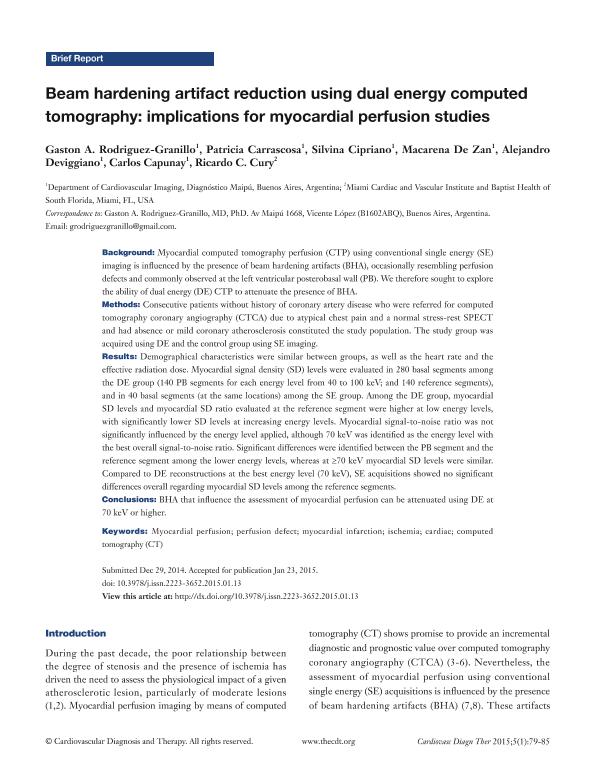Artículo
Beam hardening artifact reduction using dual energy computed tomography: implications for myocardial perfusion studies
Rodriguez Granillo, Gaston Alfredo ; Carrascosa, Patricia; Cipriano, Silvia; De Zan, Macarena; Deviggiano, Alejandro; Capunay, Carlos; Cury, Ricardo C.
; Carrascosa, Patricia; Cipriano, Silvia; De Zan, Macarena; Deviggiano, Alejandro; Capunay, Carlos; Cury, Ricardo C.
 ; Carrascosa, Patricia; Cipriano, Silvia; De Zan, Macarena; Deviggiano, Alejandro; Capunay, Carlos; Cury, Ricardo C.
; Carrascosa, Patricia; Cipriano, Silvia; De Zan, Macarena; Deviggiano, Alejandro; Capunay, Carlos; Cury, Ricardo C.
Fecha de publicación:
02/2015
Editorial:
AME Publishing
Revista:
Cardiovascular Diagnosis and Theraphy
ISSN:
2223-3652
Idioma:
Inglés
Tipo de recurso:
Artículo publicado
Clasificación temática:
Resumen
Background: Myocardial perfusion computed tomography (CTP) using conventional single energy (SE) imaging is influenced by the presence of beam hardening artifacts (BHA), occasionally resembling perfusion defects and commonly observed at the left ventricular posterobasal wall (PB). We therefore sought to explore the ability of dual energy (DE) CTP to attenuate the presence of BHA. Methods: Consecutive patients without history of coronary artery disease who were referred for computed tomography coronary angiography due to atypical chest pain and a normal stress-rest SPECT and had absence or mild coronary atherosclerosis constituted the study population. The study group was acquired using DE and the control group using SE imaging. Results: Demographical characteristics were similar between groups, as well as the heart rate and the effective radiation dose. Myocardial signal density (SD) levels were evaluated in 280 basal segments among the DE group (140 PB segments for each energy level from 40 keV to 100 keV; and 140 reference segments), and in 40 basal segments (at the same locations) among the SE group. Among the DE group, myocardial SD levels and myocardial SD ratio evaluated at the reference segment were higher at low energy levels, with significantly lower SD levels at increasing energy levels. Myocardial signal-to-noise ratio was not significantly influenced by the energy level applied, although 70 keV was identified as the energy level with the best overall signal-to-noise ratio. Significant differences were identified between the PB segment and the reference segment among the lower energy levels, whereas at ≥ 70 keV myocardial SD levels were similar. Compared to DE reconstructions at the best energy level (70 keV), SE acquisitions showed no significant differences overall regarding myocardial SD levels among the reference segments. Conclusions: Beam hardening artifacts that influence the assessment of myocardial perfusion can be attenuated using DE at 70 keV or higher.
Archivos asociados
Licencia
Identificadores
Colecciones
Articulos(SEDE CENTRAL)
Articulos de SEDE CENTRAL
Articulos de SEDE CENTRAL
Citación
Rodriguez Granillo, Gaston Alfredo; Carrascosa, Patricia; Cipriano, Silvia; De Zan, Macarena; Deviggiano, Alejandro; et al.; Beam hardening artifact reduction using dual energy computed tomography: implications for myocardial perfusion studies; AME Publishing; Cardiovascular Diagnosis and Theraphy; 5; 1; 2-2015; 79-85
Compartir
Altmétricas



